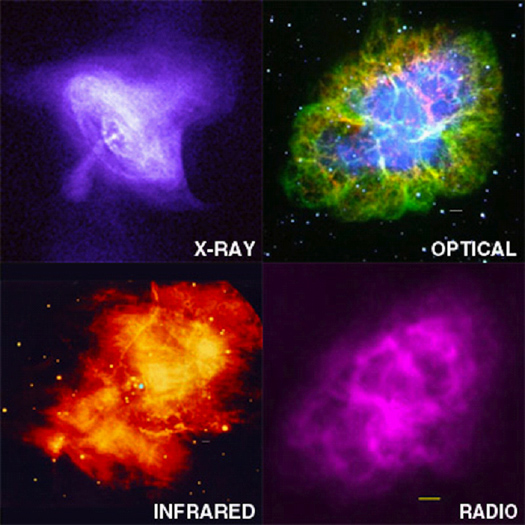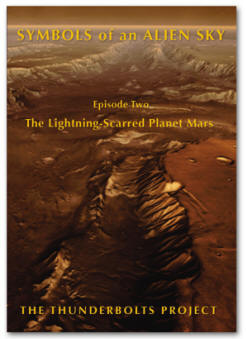|

The Crab Nebula in X-ray (Chandra),
optical (Palomar), infrared (Keck),
and radio (VLA).
Nebular Flares
Jun 30, 2011
Filamentary structures in this
nebula indicate electric currents
flowing through clouds of plasma.
NASA launched the Fermi Gamma Ray
Space Telescope (formerly
GLAST) on June 11, 2008.
Its primary mission is observing
high frequency electromagnetic waves
in space, including gamma rays.
Since gamma rays are unable to
penetrate our atmosphere, Fermi was
placed in high orbit.
Scientists from
the University of California Santa
Cruz Institute for Particle Physics
have identified 16 new so-called
"pulsars" from scans of their gamma
ray emissions. Pulsars were usually
discovered by monitoring radio
waves, but Fermi has discovered
"radio quiet" pulsars.
Pulsars are described as
"lighthouses" with concentrated
beams of energy constricted to
narrow regions on the surface of a
rapidly spinning neutron star.
Gravity relies on rotation as the
pulsation mechanism, so when a
pulsar's beam comes in line with
Earth, a flash of light can be seen.
However, the rotation rates of
some pulsars are faster than one
revolution per second (even with
many times the mass of our Sun).
Nothing known to science can
withstand the forces involved with
those spin rates, so "neutron stars"
were mathematically created. Only
something that dense was thought
able to withstand the rotational
velocity.
According to a recent
press release, one of the
most well-known pulsars, the Crab
Nebula, is emitting such extremely
energetic gamma ray bursts that
astrophysicists are reconsidering
their theories. Stefan Funk from the
Kavli Institute for Particle
Astrophysics and Cosmology (KIPAC)
at the Stanford Linear Accelerator
facility in California said:
"We thought we knew the essential
ingredients of the Crab Nebula but
that's no longer true. It's still
surprising us." KIPAC's director,
Roger Blandford agreed: "We were
dumbfounded."
The Fermi report states that the
gamma ray flares occur in short
periods of time, as little as two
days before the intensity drops back
to normal levels. In agreement with
Electric Universe theory, the
research team acknowledges that the
rapid slew rate points to
synchrotron radiation as the gamma
ray source: ten trillion electron
volts worth.
The press release also poses the
most critical question: how can the
nebula do that?
On July 4, 1054 CE, Chinese
astrologers saw a "guest star" near
Zeta Tauri in the constellation
Taurus. They record that it was
bright enough to shine in daylight,
but lasted only about a year before
fading out. John Bevis saw a bright
nebula in the reported location in
1731, with Charles Messier's
observation coming in 1758.
William Parsons, the third Earl
of Rosse, using his 72-inch, four
ton metal mirror telescope called
"the Leviathan of Parsonstown,"
wrote that the nebula resembled a
crab's claw, so it came to be named
the Crab Nebula. Consensus opinions
ascertain that the nebula is what
remains after a supernova explosion.
The lowest energy electrons emit
radio waves as they spiral in the
nebula's magnetic fields. They can
travel the farthest distance, so the
nebula's central pulsar was
initially discovered by radio
astronomers in 1968. Subsequently,
the pulsar was also catalogued as an
optical and X-ray radiation source.
The Crab Nebula pulses at 30
times per second, so by definition,
the central star rotates 30 times
per second. Electric Star theory
proposes that neutron stars are
imaginary objects. A gravity-only
cosmology requires them because the
forces generated from spinning
billions of megatons as fast as a
power drill would cause the star to
tear itself apart.
Neutron stars are supposed to
answer the question of anomalous
pulsar behavior, especially when
their brightness fluctuates over a
short time, like the Crab Nebula
pulsar. They are thought to be the
leftovers after stars "blow off"
their outer layers in powerful
explosions, leaving a super-dense
core behind. All the electrons in
the remaining stellar core are said
to be gravitationally compressed
until they combine with protons in
the nuclei, forming matter so dense
that a single teaspoon would weigh
billions of tons on Earth.
Previous
Thunderbolts Picture of the Day
articles have discussed the problems
associated with neutron stars.
Primarily, they violate the "Island
of stability" principal. The
number of neutrons plotted against
the number of protons in elemental
nuclei reveals a ratio of about
one-to-one for light elements and
one point five-to-one for heavier
ones. Anything outside that range
will spontaneously decay until it
reaches equilibrium. Too few
neutrons and atoms will emit protons
until they stabilize or vise-versa.
Therefore, an atomic nucleus
consisting of neutrons alone would
be unstable and immediately decay.
Pulsars are thought to form when
a neutron star's magnetic field
exceeds 10^15 Gauss. In comparison,
Earth's magnetic field measures
one-half Gauss. The evidence for
neutron stars is indirect, however,
and none have ever been observed.
What is observed are intense
magnetic fields pulsing in fractions
of a second.
Since magnetic fields are induced
by electric currents, there must be
electricity generating the intense
fields in a pulsar. Those "feeder
currents" must also be part of a
circuit, since persistent electric
current must flow in a completed
circuit. Electric Universe advocates
speculate that the oscillations in
pulsars are caused by resonant
effects in those circuits. The
sudden release of stored electrical
energy in a “double layer” is
responsible for their energetic
outbursts.
As current flows through clouds
of dusty plasma, the
Biot-Savart effect draws
linear filaments together, forming
zones of compression known as
"z-pinches" or "Bennett pinches."
Depending on how much electricity is
flowing through the circuit, the
star's magnetic field will be
greatest where the current density
is at a maximum. It seems more
likely that pulsars are exhibiting
an immense accumulation of
electricity focused by a "plasma
gun" effect.
Super-dense matter and extreme
rotation are unnecessary.
Electricity flowing in circuits
provides a coherent explanation for
pulsar behavior, including gamma ray
flares, that agrees with accepted
electromagnetic theories.
Stephen Smith
 New
DVD New
DVD
The Lightning-Scarred
Planet Mars
A video documentary that could
change everything you thought you
knew about ancient times and
symbols. In this second episode of
Symbols of an Alien Sky, David
Talbott takes the viewer on an
odyssey across the surface of Mars.
Exploring feature after feature of
the planet, he finds that only
electric arcs could produce the
observed patterns. The high
resolution images reveal massive
channels and gouges, great mounds,
and crater chains, none finding an
explanation in traditional geology,
but all matching the scars from
electric discharge experiments in
the laboratory. (Approximately 85
minutes)
Video Selections
Order Link
|





 New
DVD
New
DVD

